

Original Article - Year 2023 - Volume 38 -
Treating the face of women with botulinum toxin type A: 7-year review
Tratamento da face de mulheres com toxina botulínica do tipo A: revisão de 7 anos
ABSTRACT
Introduction: Botulinum toxin type A (BTX-A) is the number one aesthetic procedure worldwide, and the difficulty in standardizing the aesthetic treatment of the face results in a broad range of treatment possibilities. The objective this study aimed to describe the author's experience treating facial wrinkles of women with BTX-A and suggest a standardized initial treatment method.
Method: A documentary retrospective review of all medical records from the main author's clinic from 2010 to 2017 in São Paulo, Brazil, was performed, searching for female patients who required the BTX-A aesthetic treatment to reduce facial wrinkles. The main author obtained, reviewed, and classified photographic data ("Carruthers Grading Scale for Forehead Lines").
Results: The BTX-A used in all patients was Botox® (Allergan Inc., Irvine, CA, USA). A total of 156 female treatments with BTX-A were identified. The average total units of BTX-A used for the referred treatment was 32.43U. The average period between treatments in the same patient was 8.73 months. All patients showed an improved "Grading Scale for Forehead Lines" post-treatment
Conclusion: The review suggests a safe and effective technique is possible with even lower complication rates than found in the literature using fewer units, resulting in lower product costs. One should always try to minimize risks in aesthetic treatments.
Keywords: Botulinum Toxins, Type A. Surgery, Plastic. Esthetics. Rejuvenation. Facial Expression
RESUMO
Introdução: A aplicação de toxina botulínica do tipo A (BTX-A) é o procedimento estético mais realizado no mundo. Não há consenso sobre a forma ideal de realizar essa aplicação, que defina os locais de aplicação e a quantidade ideal necessária para o referido tratamento. O objetivo do estudo tem como objetivos descrever a experiência do autor no tratamento das rugas faciais em mulheres com BTX-A e sugerir uma padronização para o tratamento inicial.
Método: Foi realizado um estudo documental retrospectivo de todos os prontuários médicos da clínica do autor principal, em São Paulo - SP, Brasil, desde 2010 até 2017, em busca dos dados de pacientes do sexo feminino que foram submetidas ao tratamento das rugas faciais com BTX-A, por razões estéticas. Os arquivos fotográficos foram obtidos, revisados e classificados pelo autor principal de acordo com a "Carruthers Grading Scale for Forehead Lines".
Resultados: A BTX-A utilizada em todas as pacientes foi: Botox® (Allergan Inc., Irvine, CA, USA). Um total de 156 tratamentos com BTX-A foi encontrado. A média de unidade de toxina utilizada para o tratamento foi de 32,43U. O período médio de retorno para nova aplicação, na mesma paciente, foi de 8,73 meses. Todas as pacientes apresentaram melhora da classificação obtida através da "Grading Scale for Forehead Lines" após o tratamento.
Conclusão: A revisão sugere que uma técnica efetiva e segura para o tratamento é possível, com menos unidades e menor taxa de complicações, quando comparada à literatura. Devemos sempre minimizar os riscos em tratamentos estéticos.
Palavras-chave: Toxinas botulínicas tipo A; Estética; Procedimentos cirúrgicos reconstrutivos; Rejuvenescimento; Expressão facial
INTRODUCTION
According to the International Society of Aesthetic Plastic Surgery (ISAPS), the number of aesthetic surgical and nonsurgical procedures was estimated at 24.5 million in 2020. Botulinum toxin type A (BTX-A) is the leading aesthetic procedure, with over 6.2 million injections1. Formerly, the BTX-A treatment simply aimed to reduce wrinkles. Actually, appearance harmonization and aging sign correction by preserving an increasingly natural and lively appearance have become aesthetic goals. This specific result is usually derived from a wider distribution of toxins for each muscular area2.
The lack of evidence evaluating many techniques described to treat facial wrinkles with BTX-A (Table 1) results in a large variety of points and units to treat each area. Most articles assessed outcomes with subjective and arbitrary scales that only compared results with pictures at pre- and post-procedure3. Currently, the referred treatment is based on expert consensus and personal experience. A larger and more detailed series of cases and prospective studies are required.
| Author (year) | Frontal Region (IS / U) | Periorbital (IS / U) | Glabela (IS / U) | Nasal (IS / U) | Total Units |
|---|---|---|---|---|---|
| Carruthers et al.4 (2008) | 4-8 I.S. / 6-15 U | 4-10 I.S. / 10-30 U | 5-7 I.S. / 10-30 U | - | 26-75 U |
| Sepehr et al.5 (2010) | - / 6-12,5 U | - / 10-24 U | - / 15-42 U | - / 4 U | 35-82.5 U |
| Berbos & Lipham6 (2010) | 5 ou 9 IS / 5-22,5 U | 2-3 IS / 10-30 U | 5 IS / 17,5-25 U | - | 32.5-77.5 |
| Cartee & Monheit3 (2011) | 6-8 IS / 12-32 U | 6 IS / 12-24 U | 5 IS / 20 U | 2 IS / 4-8 U | 48-94 U |
| Hexsel et al.7 (2011) | 5-10 IS / 10-40 U | 6 IS / 10-30 U | 5-6 IS / 10-40 U | 2 IS / 4-8 U | 34-118 U |
| Jaspers et al.8 (2011) | 5-7 IS / 20-28 U | 6 IS / 24 U | 5 IS / 20 UI | - | 64-72 U |
| Ahn et al.9 (2013) | 6-9 IS / 6-13,5 U | 6 IS / 14 U | 3 IS / 8 U | 3 IS / 6 U | 34-41.5 U |
| Gendler & Nagler10 (2015) | 5-10 IS / U variable | Many IS / 8-12 UI | 3-5 IS / 20 U | 2 IS / 4-8 U | - |
| Gart et al.11 (2015) | 6 IS/ 24-36 U | 6 IS / 18-30 U | 5 IS / 5 U | 2 IS / 6-10 U | 53-81 U |
| De Maio et al.12 (2017) | 5-7 IS / - U | 6 IS / - U | 5 IS/ - U | - | - |
Therefore, this study aimed to describe the author’s experience treating facial wrinkles of women with BTX-A and suggest a standardized initial treatment method.
OBJECTIVES
This study aimed to describe the author’s experience in treating facial wrinkles of women with BTX-A and to suggest a standardized initial treatment method.
METHODS
A scientific literature review was performed by the main author with an online search of PubMed (NCBI, U.S. National Library of Medicine) with the Medical Subject Headings (MeSH) “botulinum toxin and aesthetics.” The initial search resulted in 8.171 papers. All titles and abstracts were read and screened, with 95 papers requested. These were read fully, and 16 main papers were identified. Furthermore, a manual search was conducted for additional references and protocols in the American Academy of Dermatology and American Society of Plastic Surgeons and at the cross references of selected papers, resulting in the referred papers in the “References” section. The ABC Medical School Research Ethics Committee approved the project under number 1.813.647.
The data were collected by performing a documentary retrospective review of all medical records from the author’s clinic in São Paulo, SP, Brazil, searching for female patients who had been treated with BTX-A to reduce the superior third of the face rhytides (main outcome), from March 2010 to August 2017. The treatment with BTX-A was conducted according to Gimenez et al.13 recommendation and considering the anatomic study of the occipitofrontal muscle published by Glattstein et al.14.
Photographic data from the clinic’s patients were retrospectively reviewed by searching pictures at pre-and post-treatment (14 days reevaluation). Then the frontal region static rhytides were randomly classified by the main author, as described by Carruthers et al.15. Afterward, the data were compiled to compare frontal wrinkle grading at pre-and post-treatment in the same patient.
To allow comparison with the literature, only the approximate average cost of BTX-A in Brazil (Botox, US$ 200,00 – 100 U) was considered.
Statistical analyses were carried out with percentage, average (AVG), and standard deviation (STD) using Microsoft Excel®.
The project was approved by the ABC Medical School Research Ethics Committee (number 1.813.647).
The study follows STROBE recommendations and has no sponsor or conflicts of interest.
RESULTS
The documentary review resulted in 53 female patients who underwent 156 treatments with BTX-A, with an average age of 45.11 years.
Complete patient photographic records (pre- and post-treatment) were found in 46 of 156 treatments (Figures 1A-H e 2A-H). The patients’ frontal static rhytides were classified as previously described. About 5% were classified as 0 and had no wrinkles at pre or post-procedure; 48% were classified as 1 at pretreatment, and all of them had their rhytides classified as 0 at post-treatment; 33% were classified as 2 at pretreatment, and 70.58% had total remission of wrinkles at post-treatment (classified as 0); 9% were classified as 3 before the treatment and 50% were classified as 0 at post-treatment; and 5% were classified as 4 and were classified as 1 or 2 at post-treatment, evidencing only partial remission of the static wrinkles.
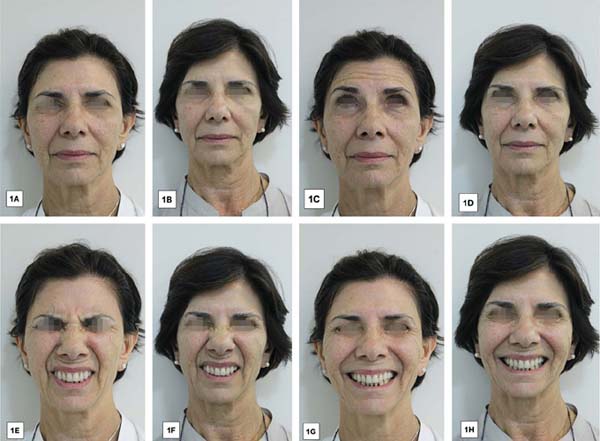
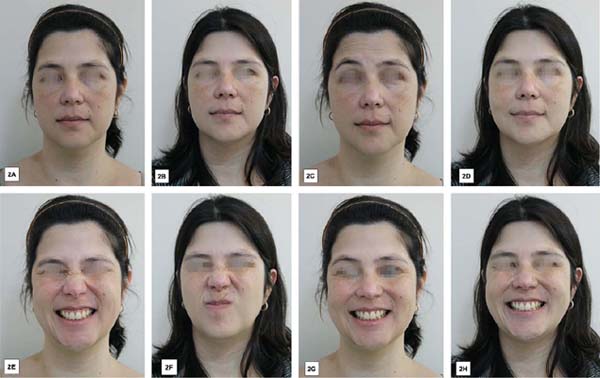
The AVG total of units (U) used to treat patients was 32.43 U, with the variations observed in Graphic 1.
The frontal region was treated with a range of 11–16 injection sites (I.S.) (AVG = 12.08; STD = 0.58 – Graphic 2) and between 11-26 U (AVG = 14.10 U; STD = 2.44 – Graphic 3).
The glabellar area was treated with 3 I.S. in all patients (Graphic 2), with a range of units between 3 and 12 U (AVG = 6.02; STD = 1.65; Graphic 3).
The nasal dorsum area was treated with 3 I.S. in all patients (Graphic 2), with a range of 0-16 U (AVG = 5.55; STD = 2.03; Graphic 3).
The periorbital area was treated with a variation from 2 to 10 I.S. (AVG = 4.70; STD = 1.24; Graphic 2) and–2-16 U (AVG = 6; STD = 2.61; Graphic 3).
A schematic summary of the most common points and corresponding units found to treat the upper and middle thirds of the face in our data is shown in Figure 3.
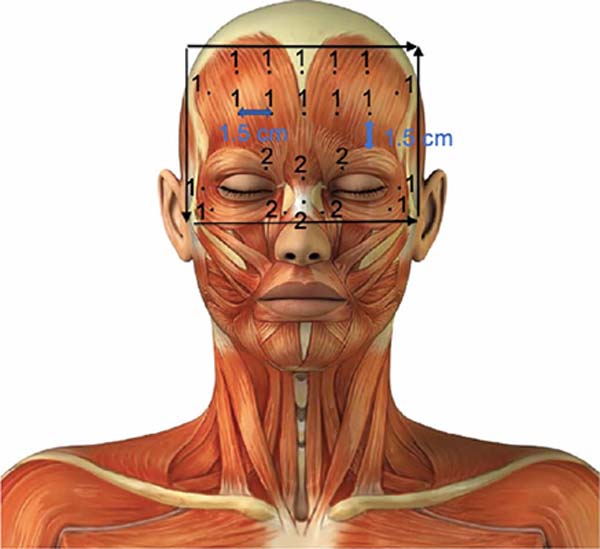
Approximately 82.69% of patients returned for a doctor reevaluation with an AVG time of 13,78 days (STD = 1.42). Approximately 6.45% of patients presented lateral eyebrow asymmetries post-procedure, corrected with 1 U reapplication at the still effective muscle. Approximately 7.09% of patients described mild bruising after injection. No patient had palpebral ptosis or headaches.
Booster injections were needed in the frontal midline area in 5.76% of patients, 8.33% in the periorbital region, and 7.69% in the glabellar area.
About 49.05 patients underwent more than one procedure, ranging from 2–12 treatments (AVG = 2.94; STD = 2.97). The average period between treatments was 262 (8.73 months; STD = 156.85 days).
Considering the average number of units found to be 32.43 U, and the average cost per unit of BTX-A in Brazil was US$ 2.00, the average toxin cost per treatment would be US$ 64.86.
DISCUSSION
The average (AVG) age of patients found in our review was 45.11 years, similar to the range in the literature: between 41.5 and 55.8 years16,17,18. The total BTX-A units to treat the superior third of the face are described as 26–118 U, as described in Table 1. The study sample oscillated at 18–54 U, with a tendency to stabilize at 28–32 U throughout the authors’ experience (Graphic 1).
In the literature, the frontal region is widely varied (4–10 I.S. and 4–40 U) (Table 1). In our experience, the number of I.S. used to treat the referred region became steady over the years, with 12 I.S. (Graphic 2) and 12 U (Graphic 3). The main idea is to distribute a smaller amount of toxin to treat the target muscle, resulting in partial paralysis to elevate the eyebrow tail discretely. The study found total or partial remission of static frontal wrinkles depending on their initial static depth.
Treating the glabellar region with 3 points instead of 5, as described in the literature, seems to preserve partial movement of the corrugator muscles, avoiding a “frozen look” and preventing the possibility of palpebral ptosis (no case was found in this review).
Treating the nasal dorsum area seems to contribute to a natural result, as these muscles directly interact with the glabellar region. Treating these muscles with intramuscular injections of 2 units of BTX-A seems sufficient for most patients.
Treating the “crows feet” is difficult because it is formed not only by the contraction of the orbicularis oculi muscle but also by the action of other muscles, such as the greater zygomatic muscle, minor zygomatic muscle, and upper lip levator muscle. Therefore, patients should be instructed that, without any muscle contraction in the face, the “crow’s feet” folds would improve with treatment but would not disappear during a forced a smile, for instance. In the author’s opinion, the attempt to treat with more points or increase the BTX–Dose does not seem to make a difference in the final result; however, more data are needed. Therefore, starting the treatment with the first point at the lateral orbital rim with an intra-dermical injection and a second point contouring the orbital rim, 1.5 cm apart from the first one, seem appropriate, as shown in Figure 1.
The total cost comparison considering the number of units found in the literature, is shown in Table 2.
| Author (year) | Units Total | Cost range in US$ |
|---|---|---|
| Carruthers et al.4 (2008) | 26-75 U | US$ 52 - US$ 150 |
| Sepehr et al.5 (2010) | 35-82.5 U | US$ 70 – US$ 165 |
| Berbos & Lipham6 (2010) | 32,5-77.5 U | US$ 65 - US$ 155 |
| Cartee & Monheit3 (2011) | 48-94 U | US$ 96 - US$ 188 |
| Hexsel et al.7 (2011) | 34-118 U | US$ 68 - US$ 236 |
| Jaspers et al.8 (2011) | 64-72 U | US$ 128 – US$ 144 |
| Ahn et al.9 (2013) | 34-41.5 U | US$ 68 – US$ 83 |
| Gendler & Nagler10 (2015) | - | - |
| Gart et al.11 (2015) | 53-81 U | US$ 106 – US$ 162 |
| AVG U described (2020) | 32.43 U | US$ 64.86 |
The reported experience suggests that treating the superior third of the face in women is a safe and effective procedure with a low complication rate compared to the literature.
Evidently, a prospective evaluation with standardized periods of reevaluation and follow-up, validation in different populations, the development of objective scales to manage wrinkles at pre and post-treatment, and the use of patient satisfaction questionnaires should be considered.
CONCLUSIONS
The review suggests that a safe and effective technique is possible with even lower complication rates than those found in the literature using fewer units, resulting in lower product costs. One should always try to minimize risks in esthetic treatments.
1. Faculdade de Medicina do ABC, Cirurgia Plástica, Santo André, São Paulo, Brazil.
2. Faculdade de Medicina do ABC, Gastroenterologia, Santo André, São Paulo, Brazil.
Corresponding author: Victor Hugo Lara Cardoso de Sá Rua Tabapuã, 1341/122, Itaim Bibi, São Paulo, SP, Brazil. Zip code: 04533-014 E-mail: vh55@uol.com.br






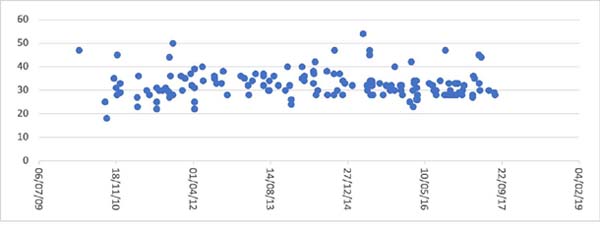

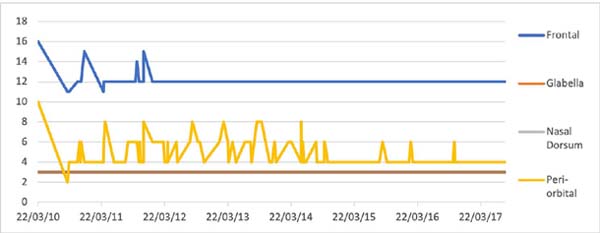

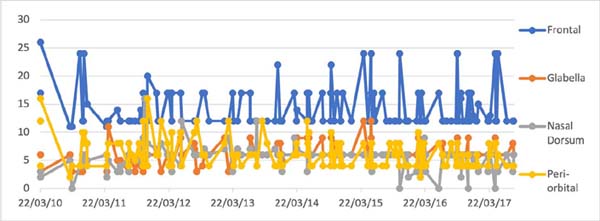



 Read in Portuguese
Read in Portuguese
 Read in English
Read in English
 PDF PT
PDF PT
 Print
Print
 Send this article by email
Send this article by email
 How to Cite
How to Cite
 Mendeley
Mendeley
 Pocket
Pocket
 Twitter
Twitter